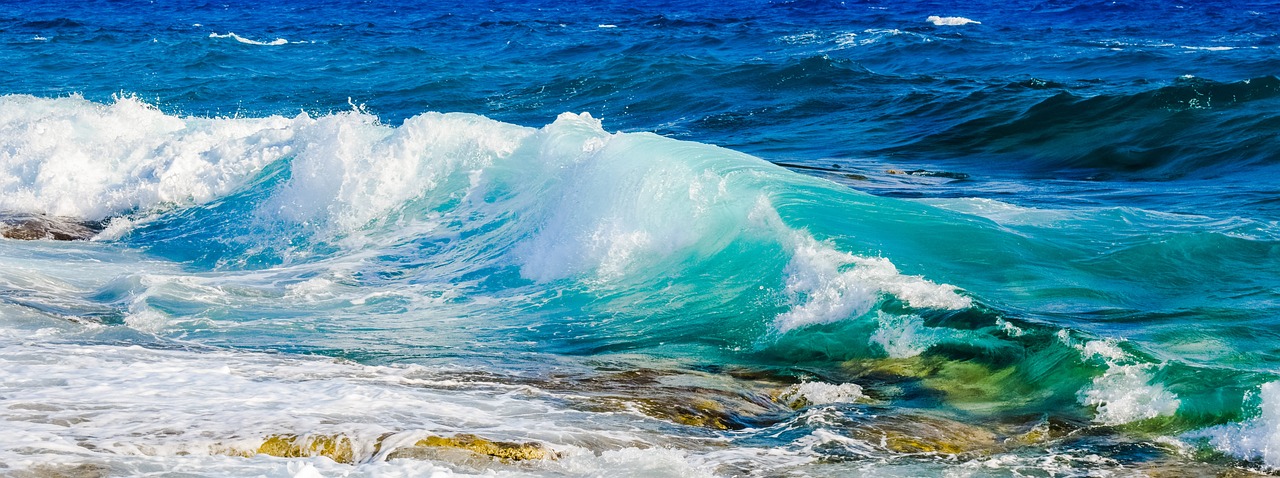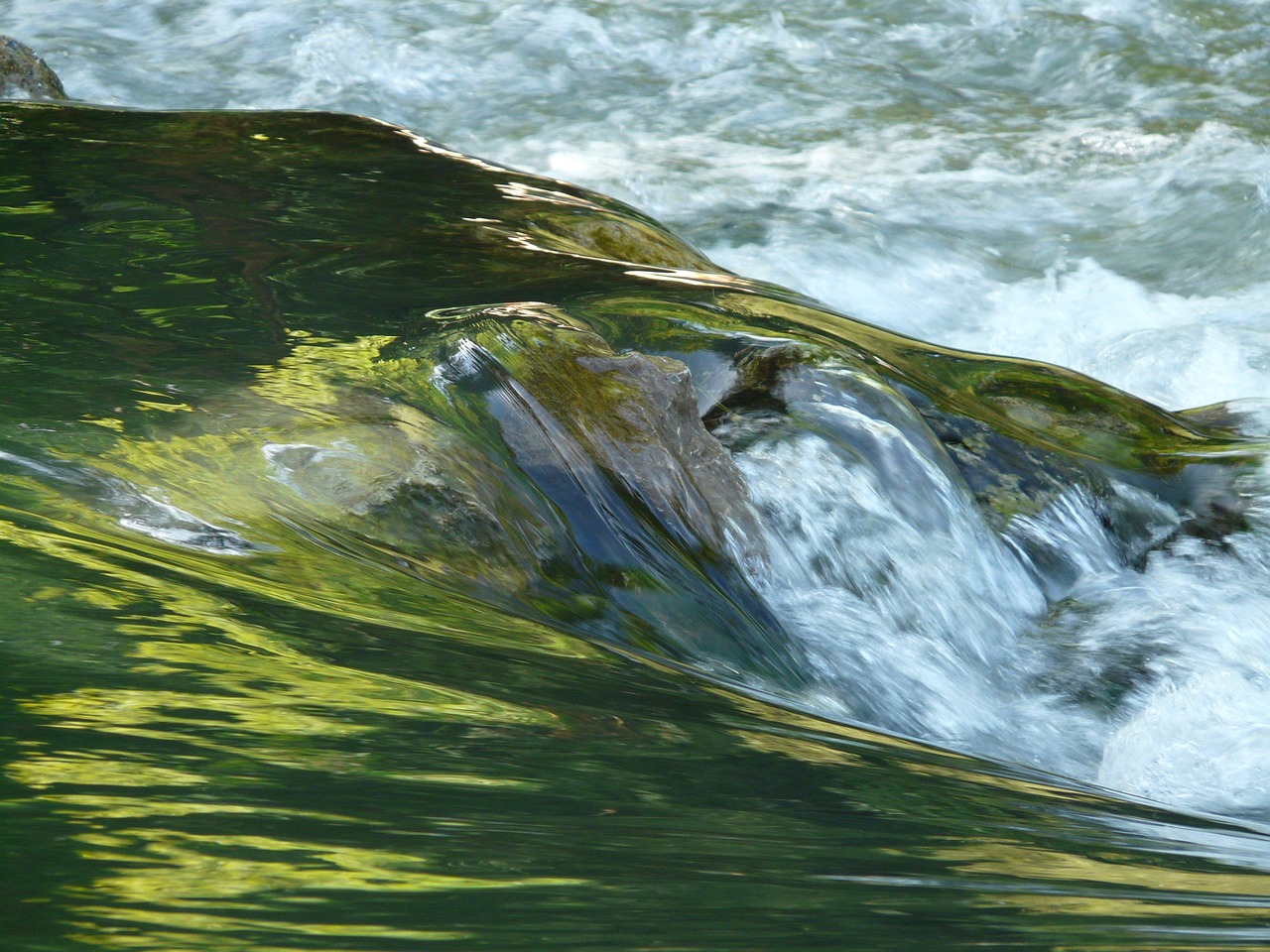This article explores the fascinating dynamics of sound transmission in water versus air, delving into the physics behind sound speed, its implications, and answering common questions about sound propagation in different mediums.
The Basics of Sound Waves
Understanding sound waves is crucial for grasping why they travel differently in various mediums. Sound waves are vibrations that propagate through a medium, and their speed is influenced by the medium’s properties. In essence, sound requires a medium—be it solid, liquid, or gas—to travel, and the characteristics of these mediums dictate the speed and efficiency of sound wave transmission.
How Sound Travels in Water
Sound travels significantly faster in water than in air due to the denser molecular structure of water. The speed of sound in water is approximately 1,480 meters per second, whereas in air, it is around 343 meters per second. This section examines the physics behind sound transmission in liquids and the factors that contribute to its speed.
- Density and Elasticity of Water: The density and elasticity of water play significant roles in sound propagation. Water’s molecular arrangement allows sound waves to transfer energy more efficiently than in less dense mediums like air.
- Impact of Temperature on Sound Speed: Temperature affects the density and elasticity of water, influencing sound speed. Warmer water allows sound to travel faster due to increased molecular activity, which enhances sound wave propagation.
Comparison with Air
Comparing sound speed in air and water highlights significant differences. The disparity in sound transmission speeds demonstrates the profound impact of medium properties on sound propagation. This knowledge is not only academically interesting but also has practical implications in various fields, including underwater acoustics and marine biology.
Applications of Sound in Water
The unique properties of sound in water have practical applications, from sonar technology in marine navigation to underwater communication systems. Understanding sound propagation is vital for these technologies, which rely on accurate data for navigation and research.
Factors Influencing Sound Speed in Water
Various factors influence how fast sound travels in water, including:
- Temperature Variations: As water temperature increases, sound waves travel faster due to the enhanced kinetic energy of water molecules, facilitating quicker energy transfer.
- Salinity Effects: Salinity alters water’s density and, consequently, sound speed. Higher salinity levels increase water density, which can enhance sound propagation, making it an important consideration in oceanography.
Real-World Examples of Sound in Water
Real-world scenarios demonstrate the principles of sound travel in water. For instance, marine animals such as dolphins and whales rely on sound for communication. Understanding how sound travels in water helps explain their vocalizations and the distances over which they can communicate.
Underwater Acoustics in Research: Scientists utilize underwater acoustics to study marine environments. Sound waves help in mapping ocean floors and tracking marine animal movements, showcasing the practical applications of sound speed in water.
Common Misconceptions About Sound in Water
Several misconceptions exist regarding sound travel in water. A common misunderstanding is that sound can travel in a vacuum. This section clarifies that sound requires a medium, such as water or air, to propagate, emphasizing the importance of molecular interactions.
Another misconception is that faster sound means louder sound. Sound speed and loudness are separate properties, with loudness determined by sound wave amplitude rather than speed. Understanding these distinctions is crucial for grasping the complexities of sound in different environments.
The Importance of Understanding Sound Propagation
Grasping how sound travels in water versus air is essential for various scientific and practical applications. This knowledge enhances our understanding of underwater environments and technological advancements in marine science. By studying sound propagation, we can improve communication systems, enhance navigation technologies, and deepen our understanding of marine ecosystems.

The Basics of Sound Waves
Understanding sound waves is crucial for grasping why they travel differently in various mediums. Sound waves are essentially vibrations that propagate through a medium, and their speed is influenced by the medium’s properties. This section delves into the fundamental characteristics of sound waves, exploring their nature, behavior, and the factors that affect their transmission.
Sound waves can be classified into two primary types: longitudinal and transverse. Longitudinal waves involve the movement of particles in the same direction as the wave, creating areas of compression and rarefaction. Conversely, transverse waves see particles move perpendicular to the wave’s direction. In the context of sound, we primarily deal with longitudinal waves, which are responsible for the sounds we hear in our environment.
One of the key factors influencing sound wave propagation is medium density. The denser the medium, the more closely packed the molecules are, allowing sound waves to transfer energy more efficiently. For instance, sound travels significantly faster in water than in air due to water’s higher density. In air, sound travels at approximately 343 meters per second, while in water, it can reach speeds of about 1,480 meters per second.
Another important aspect to consider is elasticity. Elasticity refers to a medium’s ability to return to its original shape after being deformed. A medium with high elasticity allows sound waves to travel faster because it can transmit energy more efficiently. Water, being a liquid, has a higher elasticity compared to air, which is a gas, making it an excellent medium for sound propagation.
Temperature also plays a significant role in sound speed. As the temperature of a medium increases, the kinetic energy of its molecules rises, leading to faster sound wave propagation. In water, this means that warmer temperatures facilitate quicker travel of sound waves due to increased molecular activity. This phenomenon is particularly relevant in oceanography, where varying temperatures can significantly affect underwater acoustics.
To further illustrate how sound waves behave in different environments, we can look at a few examples:
- Marine life communication: Many marine animals, such as dolphins and whales, rely on sound for communication. Understanding the speed of sound in water helps researchers comprehend how these creatures communicate over vast distances.
- Sonar technology: Sonar systems utilize sound waves to detect objects underwater. By understanding sound propagation in water, engineers can improve sonar technology for better navigation and object detection.
- Underwater acoustics in research: Scientists employ underwater acoustics to study marine environments, including mapping ocean floors and tracking marine animal movements. This research relies heavily on understanding how sound travels through water.
In summary, sound waves are complex phenomena influenced by various factors, including medium density, elasticity, and temperature. By understanding these principles, we can better appreciate how sound travels in different environments and its implications for technology and natural communication.

How Sound Travels in Water
Understanding the way sound travels in water is essential for grasping the unique properties of this medium compared to air. Sound is a mechanical wave that requires a medium to propagate, and the differences in molecular structure between air and water significantly influence sound transmission.
In water, sound travels approximately four times faster than in air. This remarkable speed can be attributed to two main factors: the density and elasticity of water. The denser molecular structure of water allows sound waves to transfer energy more efficiently than in the less dense air, leading to faster propagation.
The density of a medium is a critical factor in sound transmission. Water molecules are much closer together than air molecules, which facilitates quicker energy transfer. Furthermore, the elasticity of water, defined as its ability to return to its original shape after deformation, also enhances sound propagation. In essence, the combination of high density and elasticity in water creates an optimal environment for sound waves to travel rapidly.
Another significant factor influencing sound speed in water is temperature. As the temperature of water increases, the kinetic energy of its molecules also rises, leading to faster sound propagation. For instance, sound travels at about 1,480 meters per second in water at room temperature, but this speed can increase in warmer waters due to enhanced molecular activity.
To put this in perspective, sound travels at approximately 343 meters per second in air at room temperature. This stark contrast underscores the profound effects of the medium’s properties on sound speed. The differences in molecular arrangement and density between air and water highlight why aquatic environments are uniquely suited for sound transmission.
The unique characteristics of sound in water have numerous practical applications. Technologies such as sonar rely on sound waves to navigate and map underwater environments. Additionally, underwater communication systems utilize sound for effective information transfer among marine vehicles and divers.
Several factors can further influence sound speed in water, including salinity and pressure. Each of these elements plays a role in altering the density and elasticity of water, thus affecting sound propagation.
Higher salinity levels increase the density of water, which can enhance sound speed. This phenomenon is particularly relevant in oceanography, where varying salinity levels can significantly impact sound propagation in different regions of the ocean.
Pressure also affects sound speed in water. As depth increases, so does pressure, leading to changes in both density and elasticity. This relationship is crucial for understanding sound transmission in deep ocean environments.
Real-world applications of sound in water showcase its importance in various fields. For example, marine animals such as dolphins and whales use sound for communication over long distances. Their vocalizations are adapted to the unique properties of sound in water, allowing them to convey messages effectively.
Scientists employ underwater acoustics to study marine ecosystems. Sound waves are utilized for mapping ocean floors and tracking marine life movements, demonstrating the critical role of sound propagation in advancing our understanding of underwater environments.
Despite the scientific understanding of sound transmission, several misconceptions persist. One common belief is that sound cannot travel in a vacuum. This is inaccurate, as sound requires a medium, such as water or air, to propagate. Moreover, it is essential to distinguish between sound speed and loudness; faster sound does not equate to louder sound, as loudness is determined by the amplitude of the sound wave.
Density and Elasticity of Water
Understanding the density and elasticity of water is crucial for comprehending how sound travels through this medium. These two properties significantly influence the behavior of sound waves, allowing them to propagate more efficiently than in less dense mediums like air. In this section, we will explore the science behind these properties and their implications for sound transmission in water.
The density of a substance refers to its mass per unit volume. Water has a relatively high density compared to air, which means that sound waves can transfer energy more effectively through it. When sound waves travel through water, they encounter closely packed molecules that facilitate quicker energy transfer. This results in sound traveling at approximately 1,480 meters per second in water, compared to about 343 meters per second in air.
Another essential property is elasticity, which is the ability of a material to return to its original shape after deformation. Water’s high elasticity allows it to transmit sound waves with minimal loss of energy. When sound waves pass through water, the molecular bonds can quickly adjust to the pressure changes caused by the waves, enabling efficient energy transfer. This combination of high density and elasticity creates an environment where sound can travel faster and with greater clarity.
- Efficient Energy Transfer: The molecular arrangement of water allows sound waves to transfer energy more effectively, reducing attenuation.
- Speed of Sound: The unique properties of water facilitate a significantly higher speed of sound compared to air, enhancing underwater communication.
- Applications in Technology: Understanding these properties is vital for advancements in sonar technology, underwater acoustics, and marine biology.
Moreover, the temperature of water also plays a significant role in sound propagation. As the temperature increases, the kinetic energy of water molecules rises, resulting in faster sound wave speeds. This relationship underscores the importance of environmental factors in aquatic acoustics.
In summary, the density and elasticity of water are fundamental to understanding how sound travels in this medium. The efficient energy transfer facilitated by water’s molecular structure, combined with its high elasticity, allows sound waves to propagate rapidly and effectively. This knowledge not only enhances our understanding of underwater environments but also informs various technological applications, from marine navigation to ecological studies.
Impact of Temperature on Sound Speed
Understanding how temperature influences sound speed in water is essential for both scientific research and practical applications. As temperature varies, so do the physical properties of water, which in turn affects how sound waves propagate through this medium. When examining the , several key factors come into play, including molecular activity, density, and elasticity.
As the temperature of water increases, the kinetic energy of its molecules also rises. This increase in energy leads to more vigorous molecular motion, which facilitates the transfer of sound waves. In warmer water, molecules are more active, allowing sound waves to travel more efficiently. This phenomenon is crucial in various aquatic environments, where temperature fluctuations can significantly affect communication among marine life.
Temperature not only affects molecular activity but also alters the density and elasticity of water. Generally, warmer water is less dense than colder water. However, the relationship between temperature and elasticity is more complex. As temperature rises, the elasticity of water tends to increase, which enhances sound propagation. This means that in warmer conditions, sound can travel faster due to the combined effects of decreased density and increased elasticity.
To quantify the effects of temperature on sound speed, scientists have established empirical formulas. For instance, in pure water, sound speed increases by approximately 4.0 meters per second for every 1°C rise in temperature. This relationship highlights the importance of monitoring temperature in aquatic studies, especially in environments where temperature gradients can be significant.
The practical implications of temperature effects on sound speed are far-reaching. In marine biology, understanding how sound travels in varying temperatures can aid researchers in studying animal communication. For example, dolphins and whales utilize echolocation for navigation and hunting, and changes in water temperature can influence their vocalizations and communication range.
In fields such as underwater acoustics, temperature variations are critical for accurate data collection. Sonar systems used in marine navigation and mapping rely on precise sound speed calculations. If the temperature of the water is not taken into account, the data collected can lead to significant errors in depth measurements and object localization.
Various bodies of water exhibit different temperature profiles, which can further influence sound speed. For example, in oceans, temperature layers create a phenomenon known as the thermocline, where warmer water sits above cooler water. This stratification can create distinct layers of sound propagation, affecting underwater communication and navigation.
In summary, the in water is a critical area of study that encompasses various scientific and practical applications. By recognizing how temperature influences molecular activity, density, and elasticity, researchers and practitioners can better understand sound propagation in aquatic environments. This knowledge not only enhances our comprehension of marine ecosystems but also improves technologies reliant on sound transmission in water.
Comparison with Air
When evaluating the speed of sound in different mediums, a striking contrast emerges between air and water. Sound travels at approximately 343 meters per second in air, while in water, it speeds up significantly, reaching around 1,480 meters per second. This disparity is not merely a numerical difference; it reflects the fundamental properties of the two mediums and how they interact with sound waves.
Understanding the Differences
The primary reason for this difference lies in the density and elasticity of the mediums. Water is roughly 800 times denser than air, which allows sound waves to transfer energy more efficiently. In air, sound waves must navigate through a less dense environment, which results in slower propagation. The molecular structure of water enables sound waves to transmit vibrations more effectively, leading to faster travel times.
The Role of Temperature
Temperature plays a crucial role in determining sound speed in both air and water. In water, as the temperature increases, sound waves travel faster due to increased molecular activity. For example, in warmer water, the kinetic energy of molecules rises, facilitating quicker energy transfer. Conversely, in air, while temperature also affects sound speed, the impact is less pronounced compared to water.
Salinity and Sound Speed
Another factor influencing sound speed in water is salinity. Higher salinity levels increase water density, which can enhance sound propagation. This is particularly significant in oceanography, where variations in salinity can lead to differences in how sound travels through seawater. In contrast, air’s composition remains relatively constant, limiting the influence of salinity on sound speed.
Pressure Effects
Pressure also plays a role in sound speed, especially in deep water environments. As pressure increases with depth, sound speed increases as well. This effect is less significant in air, where changes in pressure do not have as marked an impact on sound speed. Understanding these factors is essential for applications such as underwater acoustics and sonar technology.
Practical Applications and Implications
The differences in sound speed between air and water have profound implications in various fields. For instance, marine biologists study how marine animals communicate using sound, which can travel much farther underwater than in air. Additionally, sonar systems rely on the principles of sound propagation to detect objects in the ocean, demonstrating the practical applications of understanding sound speed in water.
Conclusion
In summary, the comparison of sound speed in air and water reveals significant differences rooted in the physical properties of these mediums. Understanding these differences is essential not only for scientific inquiry but also for practical applications in technology and marine biology. By grasping how sound behaves in various environments, we can enhance our knowledge of underwater ecosystems and improve technologies that rely on sound propagation.
Applications of Sound in Water
Sound plays a crucial role in various applications, especially in aquatic environments. The unique properties of sound in water, including its speed and propagation characteristics, open up a myriad of practical uses. This section delves into the significant applications of sound in water, highlighting its importance in technology and nature.
One of the most prominent applications of sound in water is sonar technology. Sonar, which stands for Sound Navigation and Ranging, utilizes sound waves to detect and locate objects underwater. This technology is essential for marine navigation, allowing vessels to avoid obstacles, locate fish, and map the ocean floor.
- Active Sonar: Emits sound pulses and listens for echoes to determine the distance and size of objects.
- Passive Sonar: Listens for sounds made by vessels or marine life without emitting sound waves.
Underwater communication systems leverage sound waves to facilitate communication between divers, submarines, and underwater robots. These systems are vital for scientific research, underwater construction, and military operations. The ability to transmit information through sound enables teams to coordinate activities effectively in environments where traditional communication methods fail.
- Acoustic Modems: Used for data transmission, allowing for real-time communication in underwater settings.
- Communication Protocols: Specialized protocols are developed to ensure reliable transmission over varying distances.
Sound is not only important for human technology but also for marine life. Many aquatic species, such as dolphins and whales, rely on sound for communication, navigation, and hunting. Understanding how sound travels in water helps researchers study these animals’ behaviors and interactions.
- Vocalizations: Marine animals use a variety of sounds to communicate, including clicks, whistles, and songs.
- Social Structures: Sound plays a critical role in maintaining social bonds and coordinating group activities.
Scientists utilize sound waves to monitor and study marine environments. Underwater acoustics are employed to gather data on ocean conditions, marine life populations, and even geological features. This research is essential for understanding climate change impacts and managing marine resources effectively.
- Mapping Ocean Floors: Sound waves help create detailed maps of the seafloor, revealing underwater topography.
- Tracking Marine Animals: Acoustic tags enable researchers to track the movements and behaviors of marine species over time.
In addition to scientific research, sound in water has significant industrial applications. Industries such as oil and gas exploration utilize underwater acoustics to locate resources beneath the ocean floor. By understanding sound propagation, companies can enhance their exploration techniques and minimize environmental impacts.
- Seismic Surveys: Sound waves are used to identify potential oil and gas reserves, helping to inform drilling decisions.
- Construction Projects: Acoustic methods are employed to assess underwater conditions before construction, ensuring safety and efficiency.
In summary, the applications of sound in water are vast and varied, impacting technology, marine life, and scientific research. Understanding sound propagation not only aids in the development of advanced technologies but also enhances our knowledge of the underwater world.

Factors Influencing Sound Speed in Water
Understanding the is essential for various scientific and practical applications. Sound travels through water at a much faster rate than in air, primarily due to the unique properties of water. In this section, we will explore the key elements that affect sound wave propagation, including temperature, salinity, and pressure.
Temperature is one of the most significant factors affecting sound speed in water. As the temperature increases, the kinetic energy of water molecules also increases. This heightened activity allows sound waves to propagate more quickly. For instance, in warmer waters, sound can travel at speeds of approximately 1,500 meters per second, compared to around 1,480 meters per second in cooler waters.
Salinity, or the concentration of salt in water, plays a crucial role in determining sound speed. Higher salinity increases the density of water, which can enhance the propagation of sound waves. In oceanic environments, variations in salinity can lead to differences in sound speed, making it an important consideration for oceanographers and marine biologists. For example, in areas with high salinity, sound travels faster, which can influence marine life communication and navigation.
Pressure, particularly in deep water, also affects sound speed. As pressure increases with depth, the density of water rises, allowing sound waves to travel faster. This phenomenon is particularly important for underwater acoustics, where sound can reach remarkable distances. For instance, at depths of around 1,000 meters, sound can travel at speeds exceeding 1,500 meters per second. Understanding how pressure influences sound speed is vital for technologies such as sonar and underwater communication systems.
The interplay between temperature, salinity, and pressure creates a complex environment for sound propagation in water. Changes in one factor can influence the others, leading to variations in sound speed. For example, in warmer waters with high salinity, the combined effects can result in significantly faster sound transmission. This intricate relationship is crucial for researchers studying underwater acoustics and marine ecosystems.
Understanding the factors that influence sound speed in water has numerous practical applications. For instance, in marine navigation, accurate knowledge of sound speed allows for better sonar readings, helping vessels avoid obstacles and navigate safely. Additionally, in marine biology, insights into sound propagation help researchers track animal movements and communication patterns, enhancing our understanding of marine life.
In summary, the speed at which sound travels in water is influenced by temperature, salinity, and pressure. Each of these factors plays a vital role in sound wave propagation and has significant implications for various scientific fields. By studying these influences, researchers can improve technologies and enhance our understanding of aquatic environments.
Temperature Variations
Temperature variations play a crucial role in the speed of sound in water, significantly impacting how sound waves travel through this medium. Understanding these variations not only sheds light on the physics involved but also has practical implications in various fields such as marine biology and underwater acoustics.
As the temperature of water increases, the speed at which sound travels also increases. This phenomenon can be attributed to the enhanced kinetic energy of water molecules at higher temperatures. When water is heated, its molecules move more rapidly, which facilitates quicker energy transfer between them. Consequently, sound waves can propagate faster through warmer water compared to cooler water.
| Temperature (°C) | Speed of Sound (m/s) |
|---|---|
| 0 | 1402 |
| 10 | 1440 |
| 20 | 1482 |
| 30 | 1520 |
From the table above, it is evident that as the temperature rises, the speed of sound in water increases significantly. For instance, at 0°C, sound travels at approximately 1402 meters per second, while at 30°C, it can reach up to 1520 meters per second. This increase of nearly 118 meters per second illustrates the direct correlation between temperature and sound speed.
In addition to temperature, other factors such as salinity and pressure also influence sound speed in water. However, temperature is often the most variable and easily manipulated factor, making it a primary focus in studies related to underwater acoustics. For example, in oceanographic research, scientists often monitor temperature changes to predict how sound will travel through different layers of water.
Furthermore, the impact of temperature on sound speed has significant implications for marine life. Many marine animals, such as dolphins and whales, rely on sound for communication and navigation. Changes in water temperature can affect how far their calls travel, which can influence social interactions and hunting strategies. Understanding these dynamics is essential for conservation efforts and studying animal behavior in changing ocean environments.
Moreover, the relationship between temperature and sound speed is also vital in sonar technology. Sonar systems used in submarines and fishing vessels must account for temperature variations to accurately interpret sound signals. If the temperature of the water is not considered, sonar readings may be misleading, leading to inefficient navigation or misidentification of marine life.
In conclusion, temperature variations are a fundamental aspect of sound propagation in water. As water temperature increases, sound travels faster due to the increased kinetic energy of the molecules. This relationship not only enhances our understanding of sound dynamics in aquatic environments but also has practical applications in marine biology, navigation, and conservation efforts. By grasping the intricacies of how temperature affects sound speed, researchers and practitioners can better navigate the challenges and opportunities presented by underwater acoustics.
Salinity Effects
Sound propagation in water is a complex phenomenon influenced by various factors, one of which is salinity. The relationship between salinity and sound speed is significant, especially in oceanographic studies, as it affects both the physical properties of seawater and the behavior of sound waves.
Understanding Salinity
Salinity refers to the concentration of dissolved salts in water, typically expressed in parts per thousand (ppt). In oceanic environments, salinity can vary widely due to factors such as evaporation, precipitation, and freshwater input from rivers. This variation plays a crucial role in determining the density of seawater, which in turn affects how sound travels.
Impact of Salinity on Water Density
Higher salinity levels lead to an increase in water density. Denser water provides a more efficient medium for sound wave propagation. When salinity increases, the added ions and molecules contribute to a greater mass per unit volume, allowing sound waves to transmit energy more effectively. This is particularly important in marine environments where sound is used for navigation, communication, and research.
Sound Speed Variation with Salinity
The speed of sound in seawater is influenced not only by temperature and pressure but also significantly by salinity. For instance, in typical ocean conditions, sound travels at approximately 1,480 meters per second in pure water at a temperature of 25°C. However, as salinity increases, sound speed can increase by about 4 to 5 meters per second for each increase of 1 ppt in salinity. This relationship is vital for understanding underwater acoustics and the behavior of sound in various marine scenarios.
Real-World Applications
Understanding the effects of salinity on sound speed has practical implications in various fields. For example, sonar technology used in submarines and fishing vessels relies on accurate sound speed calculations to determine distances and locate objects underwater. Additionally, marine biologists study how sound travels through different salinity levels to understand animal communication and behavior in varying habitats.
Salinity and Marine Life Communication
Marine animals, such as dolphins and whales, utilize sound for communication, navigation, and hunting. The speed at which their vocalizations travel can be affected by the salinity of the surrounding water. In areas with varying salinity, these animals may adjust their communication strategies based on how sound propagates, ensuring effective interaction with one another over long distances.
The Role of Salinity in Oceanographic Research
Oceanographers often measure salinity alongside temperature and pressure to create sound velocity profiles in the water column. These profiles are essential for accurately mapping underwater topography and studying marine ecosystems. The interplay between salinity and sound speed helps researchers understand how sound interacts with different water masses, contributing to a deeper understanding of ocean dynamics.
Conclusion
In summary, salinity plays a critical role in altering water density and sound speed, making it a key consideration in oceanography. By understanding how salinity affects sound propagation, scientists can enhance their research techniques and improve technologies used in marine exploration and conservation. As our knowledge of these dynamics expands, so too does our ability to navigate and protect our oceans effectively.

Real-World Examples of Sound in Water
Understanding the dynamics of sound travel in water is not just a scientific curiosity; it has profound implications for various fields, including marine biology, environmental science, and technology. The following examples illustrate how sound waves operate in aquatic environments, highlighting their significance in real-world applications.
One of the most fascinating aspects of sound in water is its role in marine life communication. Many aquatic animals, such as dolphins, whales, and various fish species, rely heavily on sound to interact with one another. These creatures utilize a range of vocalizations, from clicks and whistles to complex songs, to convey messages, establish social bonds, and navigate their environments.
- Dolphins use echolocation to find food and navigate, emitting sound waves that bounce off objects, helping them determine distance and size.
- Whales produce low-frequency sounds that can travel vast distances underwater, allowing them to communicate with others over hundreds of miles.
- Fish species often engage in courtship rituals through sound, with males producing calls to attract females.
Sound waves play a crucial role in scientific research, particularly in the study of underwater environments. Underwater acoustics is a field that employs sound to gather data about marine ecosystems, helping researchers understand various phenomena.
- Mapping Ocean Floors: Scientists use sonar technology, which sends sound waves to the ocean floor and measures the time it takes for the echoes to return. This process creates detailed maps of underwater topography.
- Tracking Marine Animal Movements: Acoustic tags are often attached to marine animals, allowing researchers to monitor their movements and behaviors through sound signals.
- Studying Marine Habitats: Sound is also used to assess the health of marine habitats, as different species produce unique sounds that can indicate biodiversity and ecosystem health.
Human activities, such as shipping, construction, and underwater mining, significantly impact sound propagation in water. The increased noise pollution can interfere with marine life communication, leading to stress and behavioral changes in species that rely on sound.
- Shipping Traffic: The sounds generated by ships can mask the natural sounds of marine life, making it difficult for animals to communicate.
- Underwater Construction: Activities such as pile driving produce intense sound waves that can disrupt local ecosystems and affect marine animal behavior.
- Oil Exploration: Seismic surveys used in oil exploration generate loud sounds that can have long-lasting impacts on marine habitats.
Innovations in technology harness the principles of sound travel in water for various applications. For instance, sonar technology is widely used in navigation, fishing, and military operations. This technology utilizes sound propagation to detect objects underwater, making it invaluable for safe navigation and resource management.
- Fisheries Management: Sonar helps locate fish schools, allowing for sustainable fishing practices by providing data on fish populations.
- Marine Conservation: Acoustic monitoring systems are employed to track endangered species and assess the health of marine ecosystems.
- Search and Rescue Operations: Sonar is crucial in locating submerged objects or individuals in emergency situations, showcasing its life-saving potential.
In summary, the principles of sound travel in water are not only fascinating from a scientific perspective but also have significant implications for marine life communication, research, and technology. Understanding these principles enhances our awareness of underwater ecosystems and informs our efforts to protect and manage marine environments effectively.
Marine Life Communication
Marine life communication is a captivating subject that highlights the intricate ways in which aquatic animals interact with one another. Among the most notable communicators in the ocean are dolphins and whales, both of which utilize sound as their primary means of communication. Understanding the dynamics of sound in water is essential to appreciating how these magnificent creatures convey messages over vast distances.
Sound travels differently in water compared to air, primarily due to the physical properties of the two mediums. In water, sound waves can travel approximately four times faster than in air—about 1,480 meters per second compared to roughly 343 meters per second in air. This enhanced speed is attributed to the density and elasticity of water, which facilitate the rapid transfer of sound energy.
Many marine animals, particularly dolphins and certain species of whales, employ a technique known as echolocation. This biological sonar system allows them to navigate their environment and locate prey. By emitting sound waves and listening for the echoes that bounce back from surrounding objects, these animals can form a mental map of their surroundings. This ability to perceive their environment through sound is crucial for survival in the often murky underwater world.
Marine mammals produce a variety of vocalizations, each serving different purposes. For instance, dolphins use clicks, whistles, and body language to communicate with one another. Their whistles can convey emotional states, while clicks are often used for echolocation. Similarly, whales produce complex songs that can last for hours, which are believed to play a role in mating and social bonding. These vocalizations can travel great distances, allowing individuals to connect with others across vast expanses of ocean.
Several factors influence the effectiveness of marine communication. Water temperature, salinity, and pressure can all affect sound propagation. For instance, warmer water allows sound to travel faster, while higher salinity increases water density, further enhancing sound transmission. These factors can significantly impact how well marine animals can communicate, especially over long distances.
Unfortunately, human activities pose significant threats to the natural communication systems of marine life. Noise pollution from ships, industrial activities, and underwater construction can interfere with the ability of marine animals to hear and interpret sounds. This disruption can lead to confusion and stress, ultimately affecting their social structures and survival.
Understanding marine life communication is essential for conservation efforts. Researchers are increasingly studying the acoustic environments of oceans to assess the health of marine ecosystems. By monitoring soundscapes, scientists can gather valuable data on species distribution, behavior, and the impact of human activity. This information is crucial for developing effective conservation strategies aimed at protecting these remarkable creatures and their habitats.
In conclusion, the study of marine life communication reveals the profound ways in which sound plays a pivotal role in the lives of aquatic animals. From echolocation to complex vocalizations, understanding how these animals communicate enhances our appreciation of their intelligence and social structures. As we continue to explore the oceans, it is vital to consider the impacts of our actions on their unique communication systems and strive to protect these magnificent creatures and their underwater world.
Underwater Acoustics in Research
Underwater acoustics is a vital field of study that leverages the unique properties of sound waves in aquatic environments. Scientists and researchers utilize underwater acoustics to gain insights into marine ecosystems, facilitating a deeper understanding of ocean dynamics and marine life behavior. This section delves into the practical applications and significance of underwater acoustics in research.
Sound travels more efficiently in water than in air, making it an invaluable tool for researchers studying the underwater world. The speed of sound in water, approximately 1,480 meters per second, allows scientists to collect data over vast distances, which is crucial for mapping ocean floors and monitoring marine life.
One of the primary applications of underwater acoustics is bathymetric mapping. This process involves using sound waves to measure the depth of water bodies and create detailed maps of the ocean floor. By emitting sound pulses and measuring the time it takes for the echoes to return, researchers can construct accurate topographical maps. This information is essential for various applications, including:
- Navigation: Ensuring safe passage for ships and submarines.
- Marine Habitat Studies: Identifying and preserving underwater ecosystems.
- Resource Management: Locating underwater resources such as oil and gas deposits.
Underwater acoustics also plays a crucial role in tracking the movements of marine animals. Many species, including fish, dolphins, and whales, communicate using sound. Researchers deploy acoustic tags on these animals to monitor their movements and behaviors in real-time. This technology provides valuable data on:
- Migration Patterns: Understanding seasonal movements and breeding behaviors.
- Habitat Use: Analyzing how different species utilize their environments.
- Population Dynamics: Assessing the health and trends of marine populations.
Another significant application of underwater acoustics is environmental monitoring. Sound waves can detect changes in underwater environments, such as:
- Pollution Levels: Identifying the presence of contaminants in water.
- Climate Change Effects: Monitoring shifts in marine ecosystems due to temperature variations and ocean acidification.
- Seismic Activity: Detecting underwater earthquakes and volcanic activity.
Advancements in underwater acoustics have also led to innovations in communication technologies. Scientists are developing systems that enable reliable communication between underwater vehicles and surface stations, enhancing data collection and operational efficiency in marine research.
Despite its many benefits, underwater acoustics research faces challenges, including:
- Noise Pollution: Increasing human activity in oceans contributes to background noise, which can interfere with marine animal communication and research.
- Data Interpretation: Analyzing complex acoustic data requires sophisticated algorithms and models.
Future research is focused on improving acoustic technologies and methodologies to overcome these challenges, ensuring that underwater acoustics continues to be a cornerstone of marine research.
In summary, underwater acoustics serves as a powerful tool for scientists studying marine environments. Its applications in mapping, tracking, and monitoring provide essential insights that contribute to our understanding and preservation of ocean ecosystems.

Common Misconceptions About Sound in Water
When it comes to the fascinating world of sound propagation, especially in aquatic environments, several misconceptions often arise. These misunderstandings can lead to confusion about how sound travels in water compared to air. This section aims to clarify these misconceptions and provide a deeper understanding of the science behind sound travel in water.
One of the most prevalent misconceptions is that sound travels slower in water than in air. In reality, sound travels significantly faster in water. The speed of sound in air is approximately 343 meters per second, while in water, it can reach about 1,480 meters per second. This difference is primarily due to the denseness and elasticity of water, which facilitate quicker energy transfer among molecules.
Another common belief is that sound cannot travel underwater. This is entirely incorrect. Sound requires a medium, such as air or water, to propagate. In fact, aquatic animals, including whales and dolphins, rely heavily on sound for communication, navigation, and hunting. The efficiency of sound waves in water allows these animals to communicate over vast distances.
Some people mistakenly equate the speed of sound with its loudness. It is crucial to understand that sound speed and loudness are distinct properties. Sound speed is determined by the medium’s characteristics, while loudness is related to the amplitude of the sound wave. Therefore, a sound can travel quickly but may not necessarily be loud, and vice versa.
Many believe that temperature does not influence sound speed in water. However, this is a misconception. In reality, as water temperature increases, the speed of sound also increases. This is due to the enhanced molecular activity at higher temperatures, which allows sound waves to travel more efficiently. For instance, sound travels faster in warm water than in cold water, making temperature a significant factor in sound propagation.
Some assume that sound waves behave the same way in all types of water, regardless of conditions such as salinity or pressure. However, variations in salinity and pressure can significantly affect sound speed. Higher salinity increases water density, which can enhance sound propagation, while increased pressure in deeper waters also influences sound speed.
Lastly, there’s a belief that sound cannot be effectively used for navigation underwater. This is inaccurate, as technologies like sonar rely on sound waves to detect objects and navigate underwater environments. Sonar technology utilizes the principles of sound propagation in water to map ocean floors and track marine life, demonstrating the practical applications of sound in aquatic settings.
In conclusion, understanding the science behind sound travel in water is crucial for dispelling these misconceptions. By recognizing the factors that influence sound propagation, we can appreciate the unique properties of sound in aquatic environments and their implications for marine life and technology.
Sound Cannot Travel in a Vacuum
A common misconception is that sound can travel in a vacuum. This misunderstanding arises from a lack of clarity about how sound waves function. To clarify, sound is a mechanical wave that requires a medium, such as air, water, or solid materials, to propagate. In a vacuum, where there are no molecules to transmit these vibrations, sound cannot travel at all.
Understanding Sound Waves
Sound waves are created by vibrating objects, which disturb the surrounding medium. These vibrations cause molecules in the medium to oscillate, transferring energy from one molecule to the next. In a vacuum, the absence of a medium means there are no molecules to carry these vibrations, thus preventing sound from being transmitted. This fundamental principle is crucial for understanding why sound cannot exist in a vacuum.
Why Medium Matters
The medium through which sound travels significantly affects its speed and quality. For instance, sound travels faster in water than in air due to water’s denser molecular structure. The closer proximity of water molecules allows for more efficient energy transfer compared to the more spaced-out molecules in air. Conversely, in a vacuum, there are no molecules at all, making sound propagation impossible.
Real-World Implications
This concept has practical implications in various fields, including space exploration and acoustics. For example, astronauts in space cannot communicate verbally in the absence of air; they rely on radios that transmit electromagnetic waves, which do not require a medium. Additionally, understanding sound propagation is vital in designing equipment for underwater communication, sonar, and other technologies that rely on sound transmission.
Common Misunderstandings
- Sound and Light: Many people confuse sound with light, which can travel through a vacuum. Unlike sound, light is an electromagnetic wave and does not require a medium, allowing it to travel through the emptiness of space.
- Space Sounds: While movies often depict sounds in space, such as explosions or spaceship engines, these are unrealistic. In reality, no sounds would be heard in the vacuum of space, as there is no medium for the sound waves to travel through.
Scientific Basis
From a scientific perspective, the inability of sound to travel in a vacuum is supported by the principles of physics. Theories and experiments in acoustics have consistently demonstrated that sound requires a medium for transmission. This understanding is backed by the work of physicists who have studied wave mechanics and the behavior of sound in different environments.
Conclusion
In summary, the notion that sound can travel in a vacuum is a misconception. Sound waves depend on molecular interactions within a medium to propagate. Understanding this principle not only clarifies the nature of sound but also highlights the importance of medium selection in various scientific and technological applications.
Faster Sound Equals Louder Sound
One of the most prevalent misconceptions in the realm of acoustics is the belief that faster sound implies louder sound. This notion can be misleading, as it conflates two distinct properties of sound: speed and loudness. Understanding the fundamental differences between these two attributes is crucial for grasping how sound behaves in various environments.
To begin with, sound is a mechanical wave that travels through different mediums, such as air, water, or solids. The speed of sound is influenced by factors like the medium’s density and elasticity. For instance, sound travels faster in water than in air due to the denser molecular structure of water, which facilitates quicker energy transfer. However, this increased speed does not correlate with the loudness of the sound produced.
Loudness, on the other hand, is determined by the amplitude of the sound wave. Amplitude refers to the height of the wave, which is directly related to the energy it carries. A sound wave with a greater amplitude will produce a louder sound, while one with a lower amplitude will be quieter, regardless of its speed. This distinction is essential in understanding how sound is perceived.
For example, consider a scenario where a sound travels rapidly through water. While it may reach a listener more quickly than it would in air, the volume at which the sound is heard depends on its amplitude. A whisper underwater may travel faster than a shout in the air, but the whisper will still be quieter than the shout due to its lower amplitude.
Moreover, the misconception that faster sound equates to louder sound can lead to confusion in various applications, especially in fields like sonar technology and underwater acoustics. In these areas, understanding the difference between speed and loudness is vital for effective communication and data interpretation.
In conclusion, while the speed of sound can vary significantly across different mediums, it is important to recognize that this speed does not dictate the loudness of the sound. By distinguishing between these two properties, we can gain a clearer understanding of how sound operates in our environment. This knowledge not only enhances our comprehension of acoustics but also informs practical applications in science and technology.

Conclusion: The Importance of Understanding Sound Propagation
Understanding how sound travels in different mediums is crucial for a variety of scientific and practical applications. The differences in sound propagation between water and air are not just academic; they have real-world implications in fields ranging from marine biology to underwater communication technologies.
Grasping the dynamics of sound travel is essential for several reasons. In marine science, understanding how sound waves behave underwater can enhance our knowledge of marine ecosystems. For instance, sound plays a vital role in the communication of marine animals, such as dolphins and whales, which rely on echolocation and vocalizations to navigate and interact.
In addition to its biological significance, sound propagation is integral to various technologies. Sonar systems, used for navigation and mapping the ocean floor, depend on the principles of sound travel in water. These systems utilize sound waves to detect objects underwater, making them invaluable for both military and civilian applications.
Furthermore, understanding sound in water aids in environmental monitoring. Researchers can track changes in marine habitats and monitor wildlife populations through acoustic methods. This non-invasive approach provides insights into ecosystem health and biodiversity.
The speed of sound in water is influenced by several factors, including temperature, salinity, and pressure. As temperature rises, sound travels faster due to increased molecular activity. Similarly, variations in salinity can affect the density of seawater, altering sound speed. This knowledge is crucial for oceanographers and marine engineers.
Despite advancements in understanding sound propagation, misconceptions persist. For example, some believe that sound travels faster in air because it is less dense. However, the opposite is true; sound travels significantly faster in water due to its molecular structure. Clearing up these misunderstandings is vital for accurate scientific communication and education.
In conclusion, the importance of understanding how sound travels in water versus air cannot be overstated. This knowledge is not only vital for scientific inquiry but also for practical applications in technology and environmental conservation. By continuing to explore the intricacies of sound propagation, we enhance our ability to protect marine ecosystems and develop innovative solutions for underwater exploration.
Frequently Asked Questions
- Why does sound travel faster in water than in air?
Sound travels faster in water due to its higher density and elasticity compared to air. The molecules in water are packed more closely together, allowing sound waves to transfer energy more efficiently.
- How does temperature affect sound speed in water?
Temperature plays a crucial role in sound speed. As the temperature of water increases, the kinetic energy of the molecules also increases, which facilitates faster sound wave propagation.
- Can sound travel in a vacuum?
No, sound cannot travel in a vacuum because it requires a medium, like air or water, to propagate. Without molecules to vibrate, sound waves cannot be transmitted.
- Does faster sound mean it is louder?
No, sound speed and loudness are not the same. Loudness is determined by the amplitude of the sound wave, while speed is influenced by the medium’s properties. So, faster sound doesn’t necessarily mean it’s louder.
- What factors influence sound speed in water?
Several factors influence sound speed in water, including temperature, salinity, and pressure. Each of these elements can alter water’s density and elasticity, impacting how quickly sound can travel.












